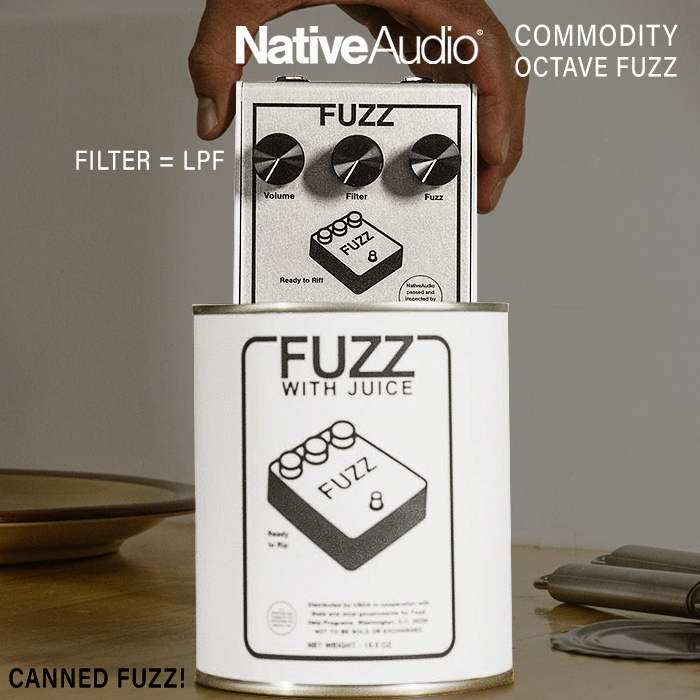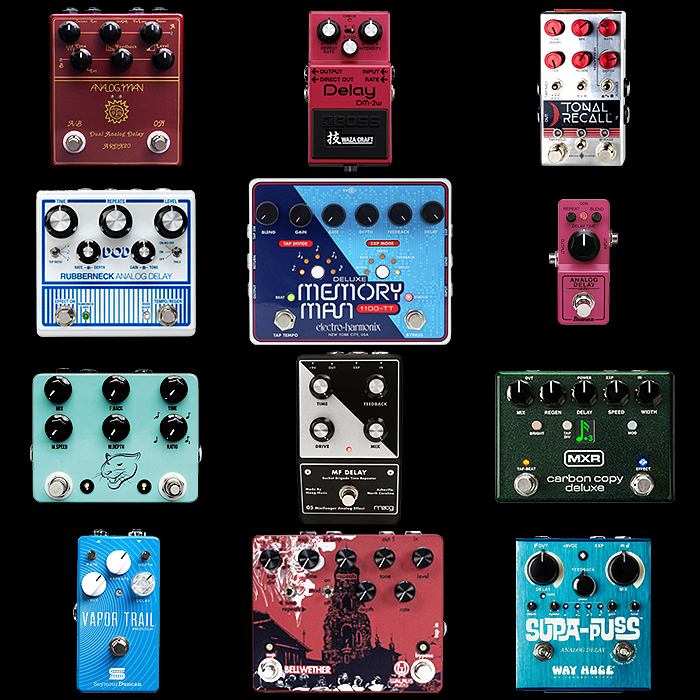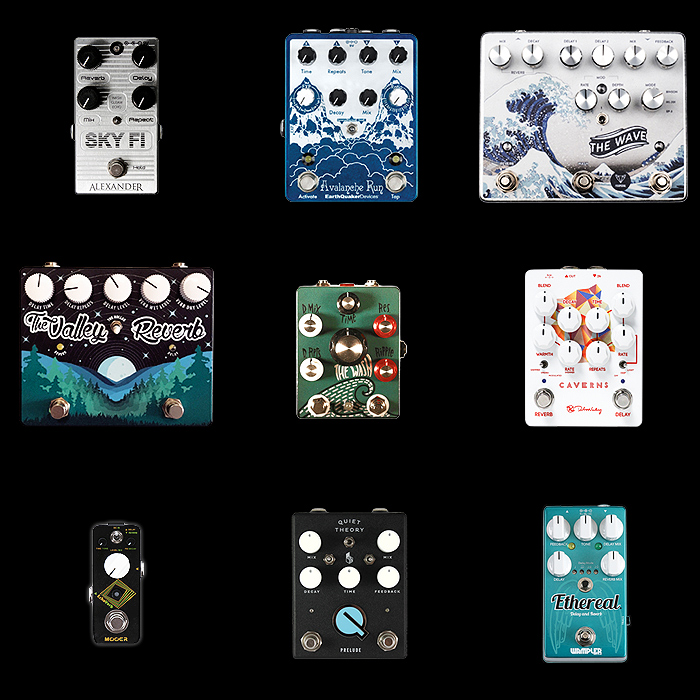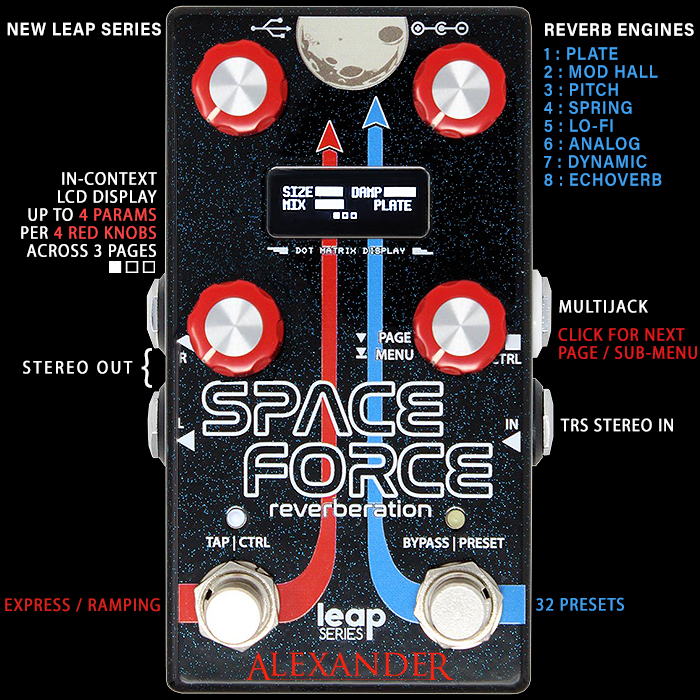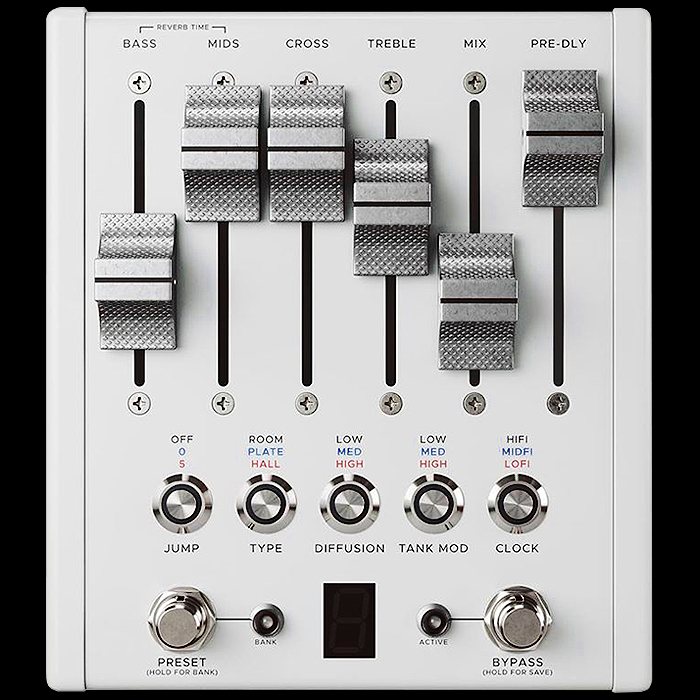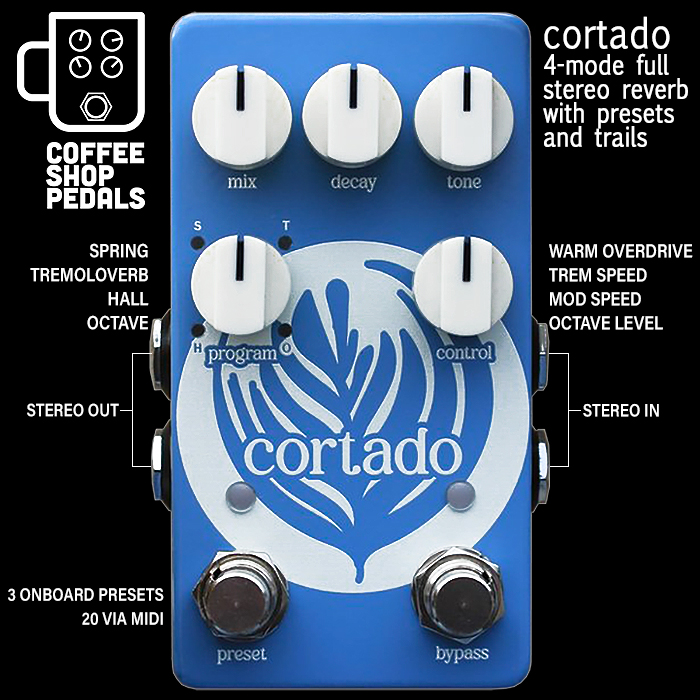Mid-Size Delay & Reverb Guitar Workshop Pedal Alternatives

As always there’s a rhyme and reason for this particular feature. My end-of-chain time-based effects are currently the Empress EchoSystem Dual Delay and Boss RV-500 Dual Reverb - both pedals in fact preceded by an Eventide H9 Max which also gives me a full range of options for both Delay and Reverb.
All these three pedals are preceded by a Boss MD-500 Modulation Workstation, but before this arrangement I used to roll with the Strymon Stryfecta of Mobius, TimeLine and BigSky. I generally feel that the Boss MD-500 is mostly preferable to the Mobius, and the RV-500 offers quite a bit more thant the Strymon BigSky - offering dual parallel / series Reverbs in stereo split - each of which can be assigned its own modulated delay - so in terms of a full-featured reverb, the Boss RV-500 is the most capable pedal of that type available. However is is the replacement for the TimeLine that is my favourite form factor - in the form of Empress Effects EchoSystem - a dual parallel / series delay with absolutely everything on board that you might need.
I have already decided that I will be replacing the Boss MD-500 with Empress’s forthcoming Zoia Multi-FX Sequencing Workstation. Yet I’m not 100% clear on the area of Reverb. If I go back in time, I was all set to go for the Source Audio Ventris, but this was so delayed in getting a release that I went down the Boss route instead. I have now witnessed several demos of the Ventris, and I am considering whether that may be a better proposition for me as my primary Reverb pedal - yet there are several cons as well as pros.
There’s also the somewhat dark horse here in the form of Meris - who does not produce full-range workstations but delivers amazing versatility and modulation potential based on just a few key algorithms. Thus in the above visual - Eventide and Source Audio provide more rounded and full-range solutions, while Meris and Stymon concentrate on just a few algorithms. All but the Strymon pedals have presets too - with the Eventide being the only one that provides a full-range of presets onboard.
These are all largely the same size - with the H9 being just a touch larger than the others featured, there can also be a significant difference in cost - so that should be considered too. If Empress brought out a dual effect version of its Reverb, I would probably go for that straightaway, while with what is currently available I am torn between going for a Ventris, or investing in a Polymoon and Mercury for more specialist purposes. Although there are 39 pedals in my chain already, I have one spare isolated power-supply slot on the second Friedman Power Grid - so I can easily go down the Meris route - in fact I may investigate that anyway at some stage, it’s just a matter of where I go first. I am not looking to get rid of any of my pedals as such - they just fall down the pecking order. It’s mostly just a matter of primary and most suitable choices.
Eventide H9 Max - £598 (All the algorithms including TimeFactor Delays)
I had always wanted one of these, and have added one to my chain fairly recently. There were several reasons I put off acquiring one of these - one of those being the high cost of the Max version, secondly I was not convinced about the control layout and actual onboard pedal access to the full range of functions - which I sorted out by adding a Barn3 OX9 add-on to the pedal - and which gives me the full range of foot-switchable functions. Finally I was not convinced by the navigation menu, and was concerned that there would be too much reliance on the Bluetooth mobile app. On having acquired the pedals, pretty much all my preconceptions hold true, but that does not mean this is not a wonderful pedal. For sake of the Delay portion, this pedal contains all of the TimeFactor algorithms and then some - with interesting pitch shifting delays that can introduce more interesting flavour in not too dissimilar way to the Meris Pollymoon. I have mentioned in previous articles that I feel Strymon has most of its competitors beat on default preset algorithms - in terms of unity volume and EQ balance - and while the H9 has some amazing algorithms and presets, there are a few defaults / presets that are suspect. I also feel that the navigation of the Eventide is somewhat clunky outside of the App - a few tweaks in interface could have improved the experience 100%. Where the H9 wins out though is in range - as nothing currently comes close to it in full potential - so £598 is a lot of outlay, but you do get a whole lot for your money too.
Eventide H9 Core - £365 (All the algorithms including Space Reverbs if you already have Max version)
If you already own an H9 Max, then you can transfer the full library of effects / algorithms to any lesser H9 variety - across as many as 5 units I believe. The lowest cost H9 is the Core - which comes with a limited subset of algorithms normally, while if you have a Max, you get everything twice over. And while I feel that there are lots of better delay pedals out there compared with the original Eventide TimeFactor pedal, I feel that the Eventide Space algorithms are still really quite special - when combined with crystalline shimmers etc. you have a magnificent Reverb pedal in this small form factor. And you often see dual H9s on pro pedalboards - total outlay here would be £963 plus the Barn3 OX9 and Tesla Tap for me x 2 - for better control. I acquired the latter from Custom Pedalboards at £89 and £33 respectively. As things stand for me right now, I will likely just go with the one H9, and have stand-alone units for the other disciplines, yet I may change my mind at some stage too, you never know. Within my current thinking I feel that there are more easily usable devices for my purposes - so practicalities and usability are of course key factors here too.
Meris Polymoon Delay - £318
As mentioned in the intro - Meris take a few algorithms and really go to town on them with modulations and unusual variations. They bill this as a super-modulated delay, which engineering and layout-wise seems to owe a little bit to the mid-size Strymon pedals. I like how there is a separate Alt (Hold) button for accessing secondary functions on each of the main dials. There's a whole load of flanger and phaser -style modulation settings available across 3 modes - Slow, Sync and Slow + Sync. This is a proper tweaker's pedal which you need to explore to find those interesting 'inbetween' settings. Spend some time here though and you will be duly rewarded by some of the most beautiful modulated delays you may ever have heard.
Meris Mercury 7 Reverb - £318
A proper sci-fi style reverb inspired by the original 1982 Bladerunner Vangelis Soundtrack. This has the same sort of layout and functionality of the Polymoon, based on 2 core algorithms in this instance - Ultraplate and Cathedra - essentially fast and slow build massive ethereal soundscapes. Has some really smart Shimmer dynamics via the Pitch Vector control, and generally excels in creating otherworldly atmospheric sci-fi sounds. It's quite evident that the Meris pedals are their own thing - very heavily directed towards more ambient players, and providing a broad range of features within a small range of algorithms. They are certainly distinctly different to the other offerings, and don't really cater to the more broadbased vanilla-type crowd. Total outlay here for both is £636.
Source Audio Nemesis Delay - £269
This mid-size delay was everyone's darling when it first came out, and was high on my wishlist for a time - that is until the just slightly larger Empress EchoSystem emerged - which to my mind improves on everything the Nemesis does - at the cost of a slightly larger footprint. In any case - the Nemesis gives you up to 8 presets onboard, and really neat fully-accessible surface controls to tweak and adjust the 12 onboard full-range algorithms. Empress gives you more of everything including dual simultaneous effects in series or parallel - so to my mind the Empress EchoSystem is still king of the delays for now. The Nemesis also has an App like the Eventide H9 - but it is not accessible via Bluetooth which is a slight disadvantage. In terms of range of features and algorithms its second only to the H9 in this feature.
Source Audio Ventris Reverb - £399
I was so keen to get my hands on this when it was first announced - it was going to be the world's first dual simultaneous reverb, but then got caught up in some engineering shenanigans which meant that the Boss RV-500 pipped it to the post. I do feel though that the extra time paid off for the Ventris as they had more time to hone and perfect their algorithms, which overall, and including the 'Spring' type sound rather more melifluous than the Boss equivalents. Source Audio have definitely followed Strymon in terms of 'flavouring' their algoritms - i.e. hitting more sweetspots by default, while Boss tends to favour a more neutral / flatter EQ approach where you add flavour to your own taste. No one has more settings and tweakability than the Boss, but the process can be complex and arduous - and of course time-consuming. With Strymon and Source Audio - the presets are tweaked for maximum first impressions - so if you just want to press and play - those are your obvious front-runners. I've stated that if Empress had a Reverb equivalent of its EchoSystem, I would jump on that immediately, but as things stand Source Audio took too long to deliver on the Ventris and I moved over to Boss in the meantime. I am now thinking that I may want to get the Ventris in place of the Boss - even though overall Boss has more on-tap as such. These are also the only two boxes that offer dual simultaneous effect capabilities across all algorithms - so it's a question if you want more tweakability or overall more ease of use. I have always liked the triple footswitches of the the larger workstations - I love the ability to easily bank up and down through 100 or more presets - yet there is much to recommend the Ventris too. Where I am leaning at the moment - I will likely acquire the Ventris at some stage - I've yet to decide where it sits in the pecking order vs my Boss RV-500 and Strymon BigSky. Acquiring both Source Audio pedals will leave you out of pocket by £668
Strymon El Capistan dTape Delay - £268
At one stage Strymon was the most significant brand in my pedal chain - with the stereo Stryfecta at the end of the chain, and the Riverside and Sunset half-way along. Since then I've bumped the Mobius, TimeLine and BigSky for the Boss MD-500, Empress EchoSystem and Boss RV-500 - and there's an Eventide H9 in their midst too. So the big Strymon workstations were my first loves in the areas of Delay and Reverb. Had I been more constrained by space, I would be looking at the smaller box solutions - or the classic Strymon mid-size pedals. I find it sort of odd that Strymon has a Jr BigSky, but not really a Jr version of the Timeline - the Timeline sort of gets split into 3 different mid-size pedals featuring Tape (El Capistan), Digital (DiG), Analogue (Brigadier) - style delays, all created via digital signal processing. Of those 3 the most appealing to me is the El Capistan, although the DiG is excellent too in its own way. Yet none of those really compete with the full-range of features of the Eventide H9 or Nemesis. For the same form-factor, and in this company, if I was just concerned with delay, my likely choice would be the Nemesis.
Strymon BlueSky Reverb - £279
The BlueSky is very much the BigSky Jr - with just 3 of its bigger sibling's algorithms and no presets, but a plethora of settings and alternative dial functions to add modulation and secondary effects. If you can do without the finer settings, you might prefer the Strymon Flint which largely has the same reverb algorithms, but this time accompanied by a separate Tremolo. For many the Strymon Flint is seen as the perfect Reverb, others rate it as a Tremolo. I've gone for the BlueSky here as it covers more generic reverb ground.
Final Thoughts
As mentioned I often write these articles to help with my own decision process and weigh up the various different pros and cons. All of the above pedals are very high quality and offer some of the most pristine high fidelity delay and reverb algorithms available - so you can kind of take it for granted that they're going to be good. From there on in it's very much a matter of personal preferences and restrictions / limits - whether pedal-board real-estate, financial or otherwise. One thing I did not mention was that all those pedals are stereo in and out - which is essential to my own stereo rig - and is the only thing that makes any sense if you want to get the most out of these pedals. I always shudder a little when I see a mono only rotary effect - for a rotary effect to be anywhere near authentic it has to be in stereo. And if you want the most out of time-based effects then the ability to pan and bounce signal across all te different areas of the soundstage is critical to the atmosphere of the final output.
So decisions get made on lots of tiny and often perceptively immaterial characteristics and differences. I personally have a real dislike of pedals which need an external app to access parts of their functionality - I get significantly put out if all the functionality is not accessible on and via the pedal's surface controls. Which is why systematically I prefer pedals like the EchoSystem and RV-500. I am annoyed that on the Ventris you need to access the app to change number of presets from 4 to 8! I am also slightly put out that the Ventris does not offer Bluetooth support, but must be connected via fixed cable - which is sort of dumbass and old-fashioned. If you are going to make use of a control methodology you should go the whole hog, not some sort of half-arsed compromise. That said, regardless of its various faults, it is the Ventris specifically that this particular article was created around. I still have some misgivings, and it is a pricey pedal at £399 - the Boss RV-500 does more for nearly £100 less or around £315.
However, for my purposes - I am really 99.99% most likely just to stick with the onboard functions of the Ventris - bar engaging the 8 presets option - which seems a lot of hassle to go to - acquire cable, download app, sync etc, for one tiny setting. From there after though I see the Ventris as mostly press and play, and the pedal experience is a lot simpler therefore than the Boss RV-500 one. I kind of feel that all these more advanced pedals with a plethora of settings should go the H9 route with full Bluetooth capabilities. For my H9 I was able to update firmware and everything simply and efficiently via Bluetooth - when I had to update the firmware on my TC Electronic Mimiq - I had to go to all sorts of trouble to find the right patch, cable up my laptop to the pedal etc - just clunky, inconvenient and pre-historic really. I can though understand why lower cost pedals would not have Bluetooth, yet I find it somewhat inexcusable that a pedal of Ventris's stature is at heart so old-fashioned. So as with most things in life, everything on this page has flaws, yet only one pedal here wins out for Reverb - and that is the Ventris. The others do cool and unusual things too, but as an all-round solution I find it a foregone conclusion that the Ventris will inevitably appear in my chain. I just need to get my other priorities out of the way first - which includes completing my '2018 Year of Fuzz' collection, and acquiring the Empress Zoia. I am also still waiting for my Origin Effects RevivalDrive to arrive, even though I was pretty much one of the first to place an order - but the pedal has been much delayed, and my own package still seems a long long way away for whatever reason. Origin have responded promptly to enquiries, but have been somewhat woolly in their responses. I had hoped I would have got mine this week, but I have an inkling of a feeling that I'm not going to see it much before the end of this month. If it drags into June, I will be more than a touch peeved...
















